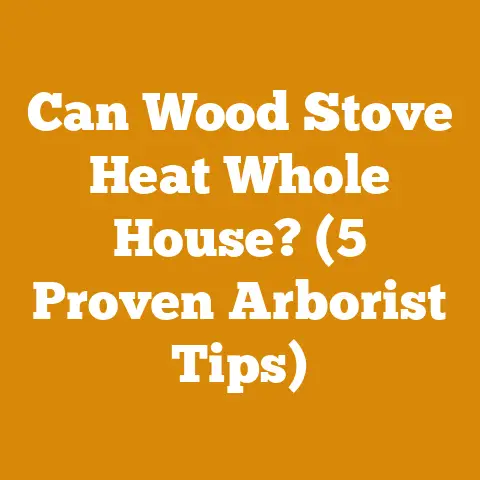Wood Stove Center of Room (5 Expert Tips for Efficient Heat)
Let’s dive into the heart of home heating – placing a wood stove in the center of a room for efficient warmth. I’ll share my expertise, gleaned from years of experience felling trees, processing wood, and advising folks on how to heat their homes safely and effectively. We’ll cover everything from stove selection to installation best practices, ensuring you get the most out of your wood-burning investment.
Wood Stove Center of Room: 5 Expert Tips for Efficient Heat
The decision to place a wood stove in the center of a room is a strategic one, aimed at maximizing heat distribution. Unlike corner or wall installations, a central location allows radiant heat to spread more evenly throughout the space. This is particularly beneficial in open-concept homes or larger rooms where a single heat source needs to cover a substantial area. But, before you start dreaming of toasty toes, there are several crucial factors to consider.
1. Choosing the Right Stove for Central Placement
Selecting the right wood stove is paramount. Not all stoves are created equal, and some are better suited for central placement than others. The key is to focus on stoves designed for radiant heat output and those with 360-degree heat distribution.
Understanding Radiant Heat
Radiant heat works by warming objects directly, rather than heating the air. This is more efficient and provides a more comfortable warmth than convection heating, which relies on circulating warm air. Stoves with large, exposed surfaces radiate heat in all directions, making them ideal for central placement.
Stove Size and BTU Output
The size of your room and its insulation level will dictate the required BTU (British Thermal Units) output of your stove. A stove that’s too small won’t adequately heat the space, while one that’s too large will result in overheating and wasted fuel.
- Calculating BTU Needs: A general rule of thumb is to use 20 BTU per square foot of living space. For example, a 1,000 square foot room would require a stove with a 20,000 BTU output. However, this is just a starting point. Factors like ceiling height, window size, and insulation quality can significantly impact heat loss.
- Overestimating vs. Underestimating: It’s generally better to slightly underestimate than overestimate. An oversized stove will force you to damp down the fire, leading to incomplete combustion, creosote buildup, and reduced efficiency. A smaller stove can always be supplemented with additional heating if needed.
Soapstone vs. Cast Iron vs. Steel Stoves
The material your stove is made from significantly affects its heating characteristics.
- Soapstone Stoves: Known for their exceptional heat retention, soapstone stoves radiate a gentle, consistent warmth for hours after the fire has died down. They are an excellent choice for central placement, providing a steady, even heat output. Soapstone stoves are often heavier and more expensive than other options, but their superior performance justifies the investment for many homeowners.
- Cast Iron Stoves: Cast iron stoves offer a good balance of heat retention and affordability. They heat up quickly and radiate heat well, but they don’t retain heat as long as soapstone stoves. Cast iron stoves are a popular choice for their classic aesthetic and reliable performance.
- Steel Stoves: Steel stoves heat up the fastest but also cool down the quickest. They are less effective at retaining heat than soapstone or cast iron. Steel stoves are often more affordable and lighter than other options, making them easier to install.
EPA-Certified Stoves
Always choose an EPA-certified stove. These stoves are designed to burn wood more efficiently and cleanly, reducing emissions and creosote buildup. EPA-certified stoves also qualify for tax credits and rebates in many areas.
- Efficiency Ratings: Look for stoves with high efficiency ratings. An efficiency rating of 75% or higher is considered excellent. This means that 75% of the energy contained in the wood is converted into usable heat.
- Emissions Standards: EPA-certified stoves must meet strict emissions standards. These standards limit the amount of particulate matter released into the atmosphere. Lower emissions not only benefit the environment but also reduce the risk of creosote buildup in your chimney.
My Experience: The Soapstone Advantage
I’ve installed countless wood stoves over the years, and I’ve consistently been impressed with the performance of soapstone stoves. One particular client had a large, drafty living room that was difficult to heat with their existing furnace. After installing a soapstone stove in the center of the room, they were amazed at the difference. The stove provided a consistent, comfortable warmth that permeated the entire space, significantly reducing their heating bills.
Takeaway: Choose an EPA-certified stove with a BTU output appropriate for your room size. Consider a soapstone or cast iron stove for superior heat retention and radiant heat output.
2. Meeting Clearance Requirements and Safety Standards
Safety is paramount when installing a wood stove, especially in a central location. Meeting clearance requirements and adhering to safety standards is non-negotiable. Failure to do so can result in a fire hazard.
Understanding Clearance Distances
Clearance distances refer to the minimum distance required between the stove and combustible materials, such as walls, furniture, and flooring. These distances are specified by the stove manufacturer and are crucial for preventing fires.
- Manufacturer Specifications: Always consult the stove manufacturer’s instructions for specific clearance distances. These distances can vary depending on the stove model and the type of wall protection used.
- Wall Protection: Using approved wall protection, such as heat shields or non-combustible materials, can reduce clearance distances. However, it’s essential to follow the manufacturer’s instructions for installing wall protection correctly.
- Floor Protection: Wood stoves must be placed on a non-combustible floor protector that extends beyond the stove’s footprint. This protects the flooring from sparks and embers. The size and type of floor protector required will depend on the stove model and local building codes.
Chimney and Flue Requirements
A properly installed chimney is essential for safe and efficient wood stove operation. The chimney must be the correct size and height to provide adequate draft and prevent backdrafting.
- Chimney Height: The chimney should extend at least 3 feet above the highest point where it exits the roof and at least 2 feet higher than any part of the building within 10 feet. This ensures adequate draft and prevents downdrafts.
- Chimney Diameter: The chimney diameter must match the stove’s flue outlet size. Using a chimney that is too small can restrict airflow and lead to incomplete combustion, creosote buildup, and carbon monoxide poisoning.
- Chimney Type: Use only approved chimney components that are designed for use with wood stoves. Class A chimneys are the most common and are designed to withstand the high temperatures produced by wood-burning appliances.
- Professional Installation: I strongly recommend having your chimney professionally installed. A qualified chimney installer will ensure that the chimney meets all safety requirements and is properly connected to the stove.
Carbon Monoxide Detectors
Install carbon monoxide detectors on every level of your home, especially near sleeping areas. Carbon monoxide is a colorless, odorless gas that can be deadly. A carbon monoxide detector will alert you to the presence of this gas, allowing you to evacuate the premises and seek medical attention.
My Fire Safety Scare
I’ll never forget the time I was called to inspect a wood stove installation that had been done improperly. The homeowner had ignored clearance requirements and installed the stove too close to a combustible wall. The wall had started to char, and a fire was imminent. Fortunately, I was able to identify the problem and correct it before a fire broke out. This experience reinforced the importance of following safety standards and seeking professional help when installing a wood stove.
Takeaway: Adhere to all clearance requirements and safety standards. Have your chimney professionally installed and install carbon monoxide detectors in your home.
3. Optimizing Heat Distribution
Placing a wood stove in the center of a room is a great start, but it’s not a guarantee of even heat distribution. You may need to take additional steps to optimize airflow and ensure that heat reaches all corners of the room.
Ceiling Fans
Ceiling fans can be used to circulate warm air downwards, preventing it from stratifying at the ceiling. Set the fan to rotate in a clockwise direction during the heating season to push warm air down.
- Fan Speed: Experiment with different fan speeds to find the optimal setting for your room. A slow fan speed is usually sufficient to circulate warm air without creating a draft.
- Fan Placement: Ensure that the ceiling fan is located in a central location and is not obstructed by furniture or other objects.
Floor Fans
Floor fans can be used to circulate warm air horizontally, helping to distribute heat to distant corners of the room. Place the fan near the stove and point it towards the area you want to heat.
- Oscillating Fans: Oscillating fans are particularly effective at distributing heat evenly throughout a room.
- Fan Height: Choose a fan height that is appropriate for your room. A taller fan will circulate air more effectively in a large room.
Heat-Powered Stove Fans
Heat-powered stove fans are small fans that sit on top of the wood stove and use the stove’s heat to generate electricity. These fans circulate warm air away from the stove, helping to distribute heat more evenly throughout the room.
- Fan Placement: Place the fan on a flat surface on top of the stove, away from the flue outlet.
- Fan Size: Choose a fan size that is appropriate for your stove and room size.
Open Floor Plan Advantages
Open floor plans naturally facilitate better heat distribution. The lack of walls and partitions allows warm air to flow freely throughout the space.
- Strategic Furniture Placement: Avoid blocking airflow with large pieces of furniture. Position furniture to allow warm air to circulate freely.
- Doorway Considerations: Consider leaving doors open to allow warm air to flow into adjacent rooms.
My DIY Heat Distribution Hack
I once helped a client with a particularly challenging heating situation. They had a large, L-shaped living room with the wood stove located at one end. The far end of the room was always cold, no matter how hot the stove was burning. I suggested using a combination of ceiling fans and floor fans to circulate the air. We placed a ceiling fan in the center of the room and a floor fan near the stove, pointing towards the cold end of the room. The result was a dramatic improvement in heat distribution.
Takeaway: Use ceiling fans, floor fans, and heat-powered stove fans to optimize heat distribution. Consider the advantages of an open floor plan and strategic furniture placement.
4. Managing Wood Storage and Handling
Proper wood storage and handling are essential for efficient and safe wood stove operation. Seasoned wood burns hotter, cleaner, and more efficiently than green wood.
Seasoning Wood
Seasoning wood involves drying it to reduce its moisture content. Green wood can contain up to 50% moisture, while seasoned wood should have a moisture content of 20% or less.
- Splitting Wood: Splitting wood exposes more surface area to the air, accelerating the drying process.
- Stacking Wood: Stack wood in a single row, with gaps between the pieces to allow for airflow.
- Covering Wood: Cover the top of the woodpile to protect it from rain and snow, but leave the sides open to allow for ventilation.
- Drying Time: Seasoning wood typically takes 6-12 months, depending on the type of wood and the climate.
Wood Storage Location
Choose a wood storage location that is convenient, accessible, and protected from the elements.
- Proximity to Stove: Store wood as close to the stove as possible to minimize the distance you have to carry it.
- Protection from Rain and Snow: Protect wood from rain and snow to prevent it from reabsorbing moisture.
- Elevated Storage: Elevate wood off the ground to prevent it from absorbing moisture from the soil.
Wood Moisture Meters
Use a wood moisture meter to check the moisture content of your wood before burning it. A moisture meter will give you an accurate reading of the wood’s moisture content, allowing you to ensure that you are burning seasoned wood.
- Target Moisture Content: Aim for a moisture content of 20% or less.
- Meter Types: Choose a pin-type or pinless moisture meter, depending on your preference.
My Wood Stacking Strategy
I’ve developed a wood stacking strategy over the years that maximizes airflow and minimizes moisture absorption. I start by building a base of pallets to elevate the wood off the ground. Then, I stack the wood in a single row, with gaps between the pieces. I cover the top of the woodpile with a tarp, but leave the sides open for ventilation. This method has consistently produced well-seasoned wood in a relatively short amount of time.
Takeaway: Season wood properly before burning it. Store wood in a convenient, accessible, and protected location. Use a wood moisture meter to check the moisture content of your wood.
5. Maintaining Your Wood Stove and Chimney
Regular maintenance is essential for safe and efficient wood stove operation. Neglecting maintenance can lead to creosote buildup, chimney fires, and reduced stove efficiency.
Creosote Buildup
Creosote is a flammable byproduct of incomplete combustion that can accumulate in your chimney. Creosote buildup is a fire hazard and should be removed regularly.
- Burning Seasoned Wood: Burning seasoned wood reduces creosote buildup.
- Burning Hot Fires: Burning hot fires also reduces creosote buildup.
- Chimney Sweeping: Have your chimney professionally swept at least once a year, or more frequently if you burn wood regularly.
Chimney Inspections
Regular chimney inspections can identify potential problems, such as cracks, leaks, and blockages.
- Annual Inspections: Have your chimney professionally inspected annually.
- Inspection After Chimney Fire: Have your chimney inspected after a chimney fire to assess the damage.
Stove Maintenance
Regular stove maintenance can extend the life of your stove and improve its efficiency.
- Cleaning the Stove: Clean the stove regularly to remove ash and debris.
- Inspecting the Gaskets: Inspect the stove’s gaskets regularly and replace them if they are damaged or worn.
- Checking the Baffle: Check the baffle regularly and replace it if it is damaged or warped.
My Chimney Cleaning Mishap
I once tried to clean my chimney myself and ended up making a huge mess. I didn’t have the right tools or the experience to do the job properly. I ended up getting covered in soot and making a mess of my living room. I learned my lesson and now always hire a professional chimney sweep.
Takeaway: Have your chimney professionally swept and inspected regularly. Perform routine maintenance on your wood stove to keep it in good working order.
By following these five expert tips, you can safely and efficiently heat your home with a wood stove placed in the center of the room. Remember to prioritize safety, choose the right stove, optimize heat distribution, manage wood storage properly, and maintain your stove and chimney regularly. With a little planning and effort, you can enjoy the warmth and comfort of a wood-burning fire for years to come.






